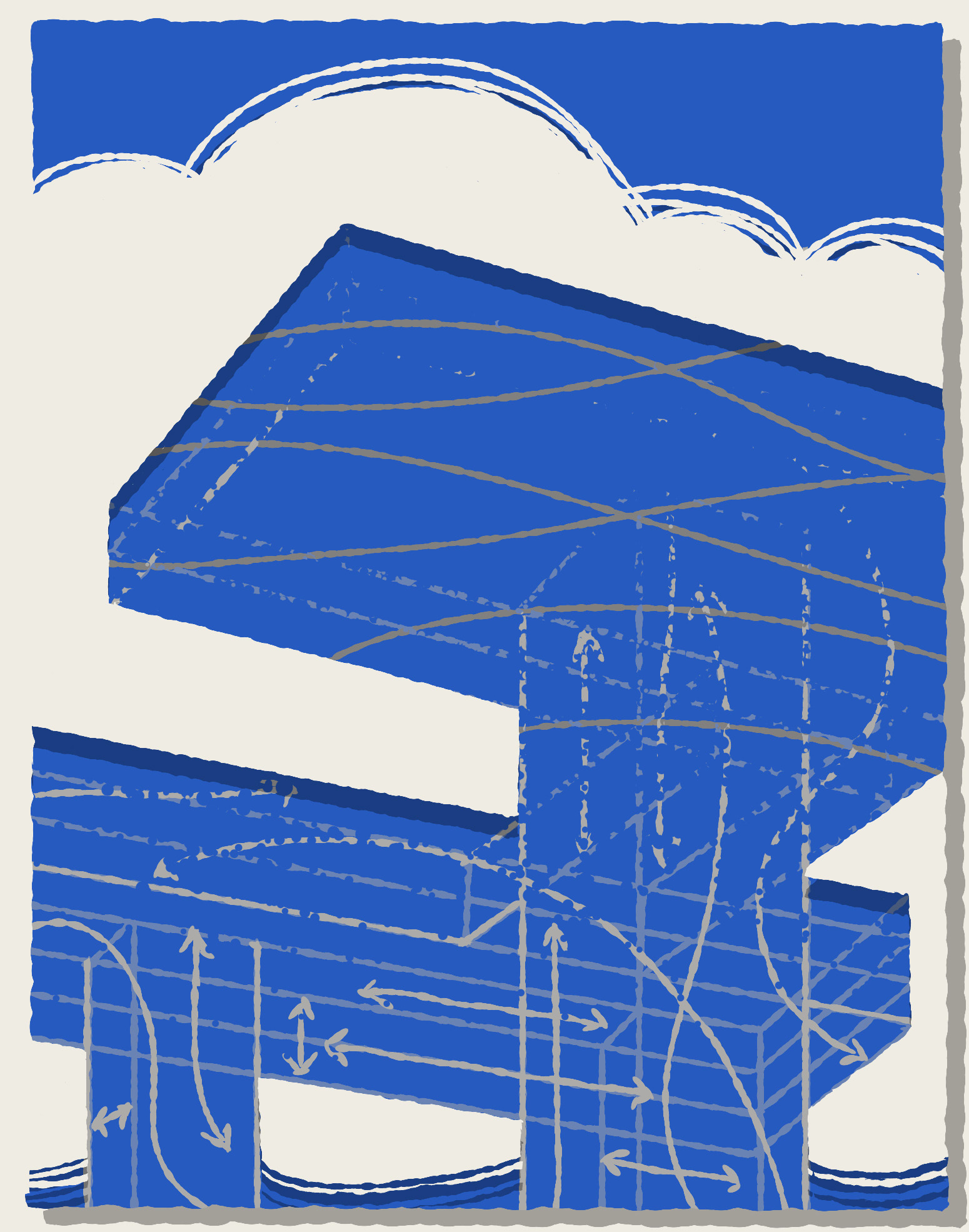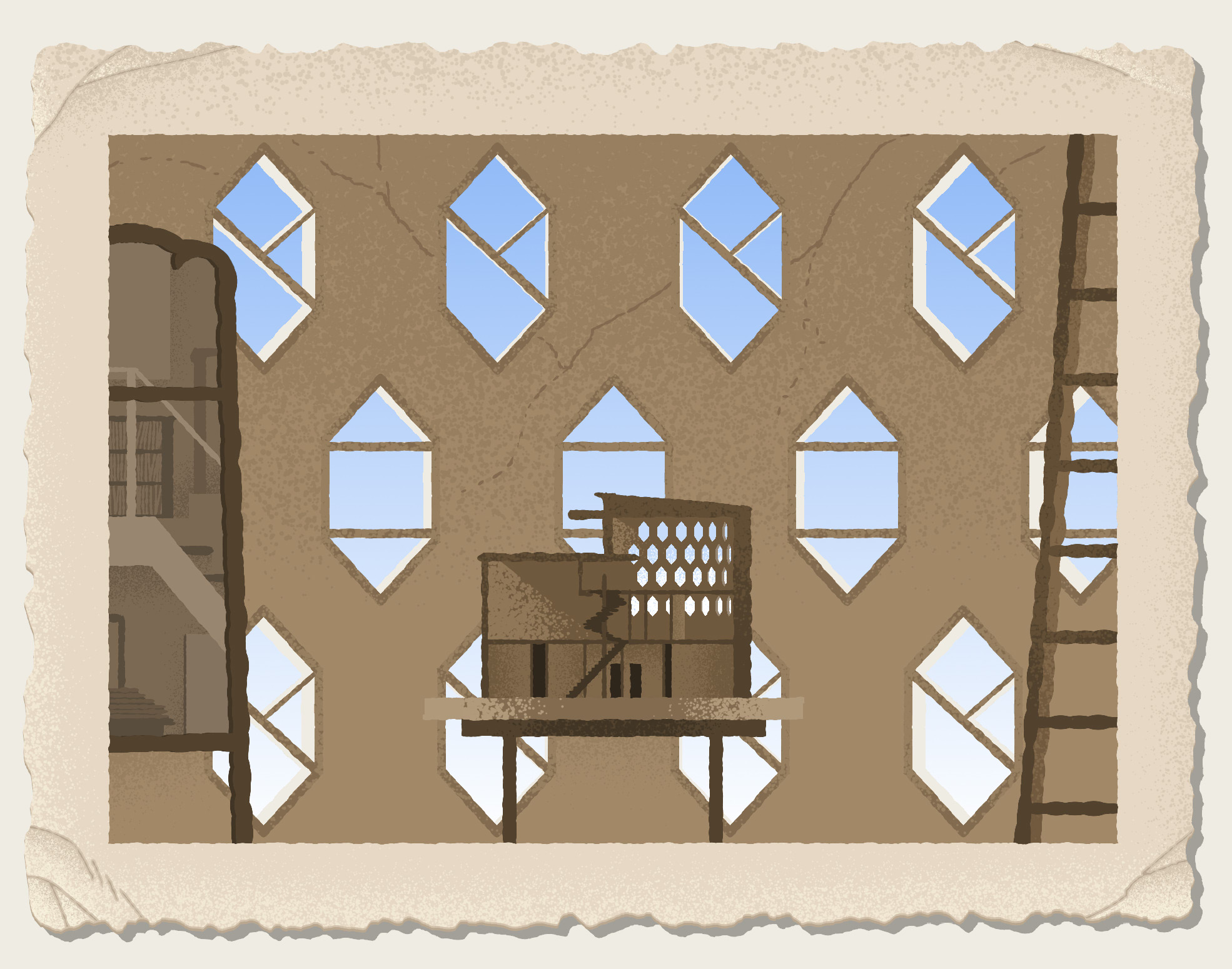Posted on 10 March 2023
When buildings aren’t constructed, we’re left to do the job of realizing them in our minds. We can turn to the proposals for the building, as well as the previous work of the architect or architects involved, for help in this task. However, we still have to put in the effort of visualizing them. Sometimes, this exercise is required as a consequence of a project that could not be materialized for financial or socio-political reasons. Other times, it is by design.
Volume 2 of Utopia Literary Journal focuses on buildings that were either unbuilt, or at risk of being unbuilt. Lissitzky's Wolkenbügel project, the Paper Architecture movement, and the Melnikov House are discussed in conjunction with the development of the videogame series Pathologic, as well as the in-game architecture of the Oneirotects.

We live in cities that were born before us. They no longer satisfy the pace and needs of our day.
– El Lissitzky, "A Series of Skyscrapers for Moscow", 1926
Buildings can’t break free of gravity. They can overcome it, to an extent, but that only comes with engineering innovations that allow for taller, heavier, and more precarious buildings to be built. The various artistic, geopolitical, and financial forces driving these innovations would be covered much more thoroughly by an architect who specializes in those intersecting forces. As I am instead a writer and artist with an interest in the form and content of these two fields, I’ll focus on comparing the ideation and construction of a particular set of buildings with those in the video game Pathologic.
In Theo van Doesburg’s 1928 essay on Utopian designs, he asks whether El Lissitzky’s unusual– and unconstructed– Wolkenbügel skyscrapers would have had “any value besides a solely speculative-aesthetic one”. Their vertical legs and horizontal upper levels resemble architecture for offshore oil rigs more than they do urban skyscrapers. It would have been an iconic sight, impressive to the locals, visitors, and opposing world powers alike. Its aesthetic and technological innovations would have, in turn, represented that of the Soviet Union, or at least what the government wished to promote.
However, its construction was labor, cost, and material prohibitive, and inhabiting it would not necessarily be comfortable, given how the summer and winter climates would affect the upper levels. The representative architecture that was built at the time, like Aleksander Rodchenko’s Workers’ Club for the 1925 Soviet Pavilion of the Paris World Fair, traded monumentality with utility. In that trade, however, they could become interchangeable with the architecture and interior design of other nations.
This question of whether something can have any value besides its speculative-aesthetic one can be applied to video games as well. Both can be tremendous undertakings whose ambitions outstrip the technology available to build them. Even when they are built, certain concepts that sound great on paper– like the flow of a room, the use of a particular material, a plotline, or a gameplay mechanic– may not be as impressive or pleasant in reality. The audiences for different genres of games come to expect certain things out of the games they are playing, and the creators of these games can also come to standardize how they work with certain technologies and stories.
This is all to say that when a video game succeeds in breaking the mold, it becomes of interest to players, developers, publishers, and people outside of the gaming world. The 2005 survival RPG Pathologic was borne out of a 1990s role-playing campaign turn chamber play that became too ambitious for its format and its players.
Nikolay loved his friends. They were amazing, creative people. But he also realized they were terrible actors.
– Carl-Johan Johansson, "In the Society of Dead Poets", 2011
When the storyline became too ambitious for the standard Dungeons & Dragon format, Nikolay Dybowski– the creator of these campaigns, as well as the director of Pathologic– turned to creating a digital database full of images, text, and pictures in order to aid the players.
However, this was still not enough. When the storylines and the acting chops required to play them out once again were outside of the scope of his friends' abilities, he looked at what else he could do with this database he had built. Ideally, the solution would allow for players to participate in and alter the storyline he had built, but would not require the in-person acting skills that theatre and Dungeons & Dragons called for.

Paper architecture works are 'projects of projects.' They are not intended for direct realization, but for mediated realization.
– Yuri Avvakumov, "Building Castle in the Sky", 2016
In retrospect, the answer to Nikolay’s problem seems obvious. Video games have become synonymous with the intersection of art, writing, and gameplay, as opposed to the individual parts in isolation. They have also become more accessible to create and publish with the resources available through the internet. However, Pathologic was developed in Moscow during the early 2000s, meaning that the pool of game developers and publishers was small, and the people willing to take the risk on such an ambitious, narrative and simulation-based project was even smaller.
The (unfortunately now defunct) Swedish gaming magazine Frienden has a wonderful, in-depth interview with the studio that Nikolay would eventually establish in order to make Pathologic, along with many other equally unusual games. It has been translated into English and is available to read for free on archive.org. I recommend the interview if you are at all interested in art history and/or game development, as well as Pathologic.
For the scope of this article, it’s important to note that Pathologic not only managed to be published (to critical acclaim, and… well, criticism), but that it contains commentary about its own form (a video game) through the in-universe, early 1900s lens of theatre and architecture. Meta-narratives in literature and roleplaying games are not a revolutionary or unheard of concept, but for a videogame from the early 2000s to integrate it with the myriad of topics it deals with, and for it not devolve into an overwrought– or even worse, forgettable– thought experiment, is notable.
That town of yours will only exist on paper... Like with the Polyhedron, it will turn into a full-sized model of itself– made of its own designs...
– The Bachelor to Peter Stamatin, "Pathologic 1", 2005
With regards to how the game comments on its own form through architecture, the works of the in-game faction known as the Oneirotects is the most clear connection. Their name quite literally means ‘dream architects’. Their structures defy– or seem to defy– natural laws like gravity, optics, and time. These buildings have only been able to be constructed under the patronage of one of three powerful and magic-blessed families in a town out in the Russian steppe.
The crowning achievement the Oneirotects is the Polyhedron. It is a hornets-nest like structure made of mirrors and steel that, to the player, seems instead to be made of its own paper schematics. Within it, a person’s fantasies are able to be materialized and played in over and over again. The town’s children have taken control of the Polyhedron, with tens of thousands of them residing in it at a time. The structure does not buckle under its own weight or the combined weight of the children, despite the only visible support being a thin metal spire leading up to the entrance at the top. The patrons of the Polyhedron allow the children to roam in the Polyhedron for now, as the structure's main purpose is to house the souls of the heads of their family when they pass away, so the family can confer with them in the future.
The Polyhedron is not just a commentary on Pathologic’s form as a videogame. Yes, it is a polyhedral object in a world made of polygons. It is a space where fantasies can be replayed in, in the same way a game can be replayed. It is a space that allows for suspension of disbelief. It is a space where there is no death– and, paradoxically, no life, as the characters in a story or game were never real. Along with this view of the Polyhedron itself, the circumstances under which it was constructed call back to a particular art-historical precedent: the 1980's Paper Architecture movement in Russia.
Paper Architecture [exists] in a parallel utopian world. In this kind of place, the architect is an iconic figure, or a worshipper.
– Yuri Avvakumov, "Building Castle in the Sky", 2016
The architects of the Polyhedron– the twin brothers Andrey and Peter Stamatin– were on the run from authorities who considered their works to be law-breaking enough to warrant being executed. Whether that meant that their work was viewed as politically dangerous, physics-defying, or otherwise offensive is left unclear. Regardless, it is only in an isolated, fairy-tale-like town that they are able to bring their magnum opus to life.
Similarly, Paper Architecture sought to bring an architect’s ideas to life through an imaginary creation, free from the constraints of customers, builders, and physics itself. It was not a unified, social push for change. Rather, it was an individual escape, or an expression of unhappiness towards a particular socio-political situation.

Our lack of funds was replaced by an abundance of architectural imagination.
– Konstantin Melnikov, "Architecture of My Life", 1985
Some works of architecture are fated to exist only on paper. Others are manifested by a combination of chance and good favors. The painter and architect Konstantin Melnikov’s home was built in Moscow between 1927 and 1929 despite Soviet restrictions on the construction of private, single-family residences. It’s rumored that his national– and international– success as an architect, as well as his hand in designing Lenin’s sarcophagus, is part of why he was allowed to build and keep such a building. Other theories are that the unique design of the internal masonry, which creates the external look of of the building being two intersecting cylinders with hexagonal windows, was intended to be reused for other buildings, and his house would serve as the test case for it.
His family has lived there since, even after the building was partially converted into a museum in 2014. The building has undergone the test of time, and in certain respects, it has failed; natural forces, bombings in the area, and poor restoration work have affected both its surface-level and structural integrity. However, it is still standing, and has also had dedicated, intensive care given to it. Preliminary studies and restoration began when it was converted into a museum in 2014, and it was shut down in October 2022 as large-scale restoration began. It is slated to become a UNESCO heritage site when restoration finishes in 2024. More information can be foutnd on the Schusev State Research Museum of Architecture's page for the Melnikov house.
It’s been really rough since the very beginning. The reason has lay not only in the financial side but also in the moral one.
– Ice-Pick Lodge, "About the Studio and Its Projects", 2022
Coming back to the discussion of Pathologic as a whole, it– like certain works aligned with Utopian and Paper Architecture movements– was intended for one medium, and ended up being manifested in another. Where they differ is that Pathologic had constraints from both its customers, builders, and audiences from the start. The collaborative nature of Dungeous and Dragons means the work was both shaped and hindered by its players. Later, when it became a game, it was fraught with scope creep and development crunch, as well as less than ideal reception from publishers and reviewers. Specifically, they did not view the game’s poor initial translation into English, as well as its clunky combat, favorably.
Additionally, Pathologic was not created once, and then left to become a relic of a particular time. It was remastered (Pathologic Classic HD), re-envisioned (Pathologic 2, which still has installations coming out), and translated countless times (officially into English, and into many other languages by fans.)
Like Melnikov's House, this videogame has been allowed to stand the test of time by virtue of being constructed. It hasn't remained a mind-game or museum showpiece meant to be viewed from the other side of a glass. It is, in a way, a living, breathing world that has been loved, reviled, revised, maintained, and ultimately nourished over time by the developers and the audience alike.
[The Polyhedron] was made for people; it is needed by people; it has no meaning without people!
Andrey Stamatin to the Changeling, “Pathologic 1”, 2005